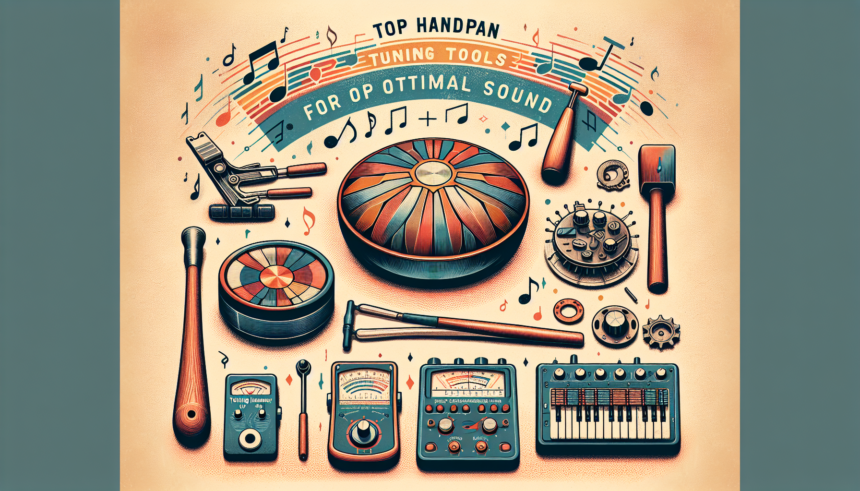The handpan, an intricate and enchanting musical instrument, requires precise tuning to achieve its signature ethereal sound. Tuning a handpan is no small feat; it demands both skill and the right tools. This article delves into some of the best handpan tuning tools available, offering valuable insights for both novice and experienced handpan tuners.
1. Tuning Forks
Tuning forks are age-old tools used in music for achieving a particular pitch. For handpan tuning, these vibrating metal forks are essential. The forks are struck and then placed on or near the handpan to check the instrument’s pitch against the desired note.
- Advantages: Extremely reliable and simple to use, tuning forks provide a pure tone that can serve as a reference for tuning the handpan.
- Disadvantages: The major limitation is that they can only produce one fixed pitch. Multiple tuning forks are needed to cover a range of notes which can be cumbersome.
2. Electronic Tuners
Electronic tuners have gained popularity due to their ease of use and accuracy. These devices, often handheld, can detect the pitch of a handpan note and display how close it is to being in tune.
- Advantages: They are highly accurate and can quickly provide readings for a broad spectrum of notes. They also feature display meters which aid in creating precise tunings.
- Disadvantages: Dependence on battery or external power sources can be a drawback, as well as the need to understand how to interpret their digital readouts correctly.
3. Tuning Hammers
Handpan tuning hammers are specialized tools used to physically adjust the pitch by tweaking the material of the handpan. These can come in various designs and are often used together with electronic tuners or tuning forks.
- Advantages: Provides fine control over the adjustments making it possible to correct flat or sharp notes delicately.
- Disadvantages: Requires skill and practice to use effectively without causing damage to the handpan.
4. Stroboscope Tuners
This sophisticated tuning tool uses a strobe light to measure the pitch. Stroboscope tuners are known for their unmatched precision, often used by professionals for fine-tuning handpans.
- Advantages: Offers extreme accuracy, allowing for precise tuning, and can handle a wide range of notes.
- Disadvantages: These can be very expensive and might require more time to understand and utilize effectively.
5. Pitch Pipes
Pitch pipes are small wind instruments that produce a reference pitch. While more common in vocal training, they can also be a helpful tuning tool for handpans, especially for quick reference checks.
- Advantages: Portable and relatively inexpensive, pitch pipes are convenient for quick and straightforward pitch checking.
- Disadvantages: They lack the precision of electronic tuners and cannot substitute for detailed tuning work.
6. Contact Microphones
When used in conjunction with digital tuners or other electronic tuning devices, contact microphones can amplify the sound of individual handpan notes, making the tuning process more manageable.
- Advantages: Enhanced sound detection, especially useful in noisy environments. They help in focusing on specific notes for more accurate tuning.
- Disadvantages: Additional equipment and wires can be cumbersome. They also require an understanding of how best to position the microphone.
7. Tuning Software
Several software programs are available that can assist in tuning handpans. When paired with a good quality laptop and microphone, these programs can quickly analyze pitches and provide detailed feedback.
- Advantages: These offer comprehensive analysis and can save records of previous tunings. Some also provide visual aids to assist in the tuning process.
- Disadvantages: They can be complicated to set up and might require payment for premium features. Dependence on a computer is another potential downside.
8. Laser Tuning Devices
Although less common, laser tuning devices can be used to measure the vibrational characteristics of the handpan’s notes. This high-tech solution provides detailed insights into how handpan steel vibrates at different frequencies.
- Advantages: Incredibly precise and can give highly detailed feedback on the tuning state of the handpan. Useful for advanced tuners seeking perfection.
- Disadvantages: Very expensive and can be overkill for casual tuners. They are also more complex to operate.
9. Analogue Tuners
Before the digital age, analogue tuners were a standard. These tuners rely on moving needle displays to indicate if a note is sharp, flat, or in tune. Though mostly replaced by digital models, they are still used by some traditionalists.
- Advantages: No need for batteries or external power sources. They are straightforward and have a nostalgic appeal.
- Disadvantages: Generally less accurate than modern digital tuners and can be harder to read and interpret.
10. Chromatic Tuners
Chromatic tuners are advanced electronic tuners that can detect and display all 12 pitches of the chromatic scale. These are particularly useful for handpan tuning where the instrument might be tuned to unconventional scales.
- Advantages: Versatile, allowing for the tuning of any note within a handpan’s range. Provides clear, precise feedback for tuning adjustments.
- Disadvantages: Require a good grasp of musical theory to use effectively, and like other electronic tuners, they depend on power sources.
Conclusion
Tuning a handpan is an art form that marries precision with musical intuition. The right tools not only facilitate this delicate process but also enable handpan enthusiasts to achieve the ethereal sounds that these instruments are famous for. From age-old tuning forks to the latest stroboscope tuners, each tool has its unique advantages and limitations. The best choice of tools depends on the tuner’s skill level, budget, and specific needs of the handpan. As technology continues to evolve, new and improved tuning tools will undoubtedly emerge, making the beautiful art of handpan music even more accessible and enjoyable for all.
FAQs
1. Do I need multiple tools to tune a handpan?
While it’s possible to tune a handpan with a single tool, using multiple tools can provide a more accurate and efficient tuning process. For instance, combining electronic tuners with tuning hammers can yield excellent results.
2. How often should I tune my handpan?
Frequency of tuning depends on how often and aggressively the handpan is played. Regular players might need to tune their handpan more often. Generally, checking the tuning every few months is a good practice.
3. Can I damage my handpan while tuning?
Yes, improper tuning techniques, especially with tools like tuning hammers, can damage the handpan. It is recommended to learn from an expert or practice cautiously to avoid causing harm to the instrument.
4. Are there any mobile apps for tuning a handpan?
Yes, there are several mobile apps available that can help in tuning handpans. These apps utilize the smartphone’s microphone to detect pitch and offer tuning suggestions, though their accuracy may vary.
5. Is it possible to change the scale of a handpan by tuning?
While minor adjustments in pitch are possible, significantly changing the scale of a handpan usually requires professional retuning by an experienced maker or tuner, as it involves more intricate and comprehensive adjustments.





